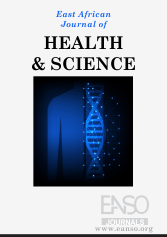The Utilization of Youth Friendly Sexual and Reproductive Health Services and its Association with Socio-demographic Factors and Knowledge in Nakuru County, Kenya
الملخص
There are global drives towards supporting adolescents' sexual and reproductive health and rights, access to and use of these services among young people in low- and middle-income countries. However, the utilization of Friendly Sexual and Reproductive Health Services remains inadequate, posing a major challenge to progress in this area. This study aimed to examine the utilization of Youth Friendly Sexual and Reproductive Health Services and its association with socio-demographic factors and knowledge in Nakuru County, Kenya. This was a cross-sectional study done in one county in Kenya purposively selected and involved a sample of 400 youths (10-24 years). The response rate was 90 % (n=400). About two-thirds (64%, n=340) of the sampled youths were affirmative to using the Youth-Friendly Sexual and Reproductive Health Services which is considered suboptimal. Whereby it is evident that Kenya is doing better in the utilization of Youth-Friendly Sexual and Reproductive Health Services than its peer countries in the region, it has not achieved the target of 85% utilization as envisaged in the Adolescent Reproductive Health and Development Plan of Action 2005-2015. The utilization of Youth-Friendly Sexual and Reproductive Health Services of significantly associated with the level of education (x2(2) =0.256, p=0.002) and awareness/being knowledgeable (x2(1) =0.019, p=0.001) on Youth Friendly Sexual and Reproductive Health Services. This study thus recommends that policies and programs to upscale the utilization of Youth-Friendly Sexual and Reproductive Health Services should focus on building a knowledge base for the youths on the said subject. Furthermore, the curriculums should introduce aspects of Youth-Friendly Sexual and Reproductive Health Services early enough in the primary school level to formally expose them to sexual health knowledge and eventually improve utilization
التنزيلات
المراجع
Chandra-Mouli, V., McCarraher, D. R., Phillips, S. J., Williamson, N. E., & Hainsworth, G. (2014). Contraception for adolescents in low and middle-income countries: Needs, barriers, and access. Reproductive Health, 11(1), 1. https://doi.org/10.1186/1742-4755-11-1
Chidwick, H., Baumann, A., Ogba, P., Banfield, L., & DiLiberto, D. D. (2022). Exploring adolescent engagement in sexual and reproductive health research in Kenya, Rwanda, Tanzania, and Uganda: A scoping review. PLOS Global Public Health, 2(10), e0000208. https://doi.org/10.1371/journal.pgph.0000208
Embleton, L., Braitstein, P., Di Ruggiero, E., Oduor, C., & Wado, Y. D. (2023). Sexual and reproductive health service utilization among adolescent girls in Kenya: A cross-sectional analysis. PLOS Global Public Health, 3(2), e0001508. https://doi.org/10.1371/journal.pgph.0001508
KNBS. (2019). 2019 Population and Housing Census [Https://www.knbs.or.ke › reports › kenya-census-2019]. Kenya Population Census 2019.
Mbeba, R., Mkuye, M., Magembe, G., Yotham, W., Mellah, A., & Mkuwa, S. (2012). Barriers To Sexual Reproductive Health Services And Rights Among Young People In Mtwara District, Tanzania: A Qualitative Study. The Pan African Medical Journal, 13.
Ministry of Health (MOH), Kenya. (2018). Kenya National Cancer Screening Guidelines. Government of Kenya.Nairobi.
Mmari, K., & Sabherwal, S. (2013). A Review of Risk and Protective Factors for Adolescent Sexual and Reproductive Health in Developing Countries: An Update. Journal of Adolescent Health, 53(5), 562– 572. https://doi.org/10.1016/j.jadohealth.2013.07.018
Murigi, M. W., Mogale, R. S., & Moagi, M. M. (2020). Youth’s Perspectives on a Sustainable Model for the Provision of Youth Friendly Sexual and Reproductive Health Services in Kenya: A Quantitative Approach. Journal of Biosciences and Medicines, 08(08), 100–115. https://doi.org/10.4236/jbm.2020.88010
Mutua, F. M., Karonjo, J., Nyaberi, J. M., Wanyoike, P. K., Kausya, J., & Mugai, F. (2020). Socio-demographic and economic factors influencing utilization of youth friendly reproductive health services among youths in selected universities in Nairobi County, Kenya. International Journal Of Community Medicine And Public Health, 7(7), 2437. https://doi.org/10.18203/2394-6040.ijcmph20202962
National Council for Population and Development (NCPD). (2010). Kenya National Adolescents and Youth Survey, Nairobi County.
National Guidelines for Provision of Adolescent Youth-Friendly Services (YFS) in Kenya. (2015).
Ninsiima, L. R., Chiumia, I. K., & Ndejjo, R. (2021). Factors influencing access to and utilisation of youth-friendly sexual and reproductive health services in sub-Saharan Africa: A systematic review. Reproductive Health, 18(1), 135. https://doi.org/10.1186/s12978-021-01183-y
Nyaga, L. N. (2023). Strategies Influencing Provision of Adolescent and Youth Friendly Services Within the Public Health Facilities in Migori County. KeMU.
Pew Research Center. (2017). The Future of World Religions: Population Growth Projections, 2010– 2050. https://www.pewresearch.org/religion
Population Reference Bureau. (2024). World Population Data Sheet. PRB, Washington DC.
UNESCO. (2021). Education and Learning in Africa: Status and Challenges. UNESCO ON EDUCATION.
UNFPA. (2021). My Body, My Life, My World: Rights and Choices for All Adolescents and Youth. United Nations Population Fund.
World Health Organization (WHO). (2020). Global strategy to accelerate the elimination of cervical cancer as a public health problem. World Health Organization Cervical Cancer Strategy. https://www.who.int/
الحقوق الفكرية (c) 2025 Vincent Kiprono Mukthar, PhD, Hellen Chebet Langat, Eunice Jepchumba

هذا العمل مرخص حسب الرخصة Creative Commons Attribution 4.0 International License.




























